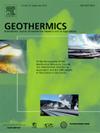Effect of Ethylenediaminetetraacetate (EDTA) on the polymerization and adsorption of silicic acid in the presence of iron: Implication to the prevention of silica scale formation from acidic geothermal water
IF 3.5
2区 工程技术
Q3 ENERGY & FUELS
引用次数: 0
Abstract
As conventional geothermal energy resources are increasingly explored and exploited, there is a need to explore non-conventional geothermal energy resources for future development of geothermal energy, such as using acidic geothermal water. However, studies have shown that simple neutralization of the acidic water might bring a risk of silica scaling due to the metal contents, such as iron (Fe). Therefore, in this study, the chelating effect of ethylenediaminetetraacetate (EDTA) on Fe was examined to prevent the polymerization of silicic acid, its precipitation, and its adsorption on the surface of silica gel. Results of laboratory experiments showed that adding Fe(III) accelerated the polymerization of silicic acid when NaOH was used to adjust the pH of acidic geothermal water. On the contrary, the acceleration effect of Fe(III) was not observed when EDTA·4Na was used to adjust the pH. The concentration of monomeric Fe(III) immediately decreased to almost 0 after adding EDTA·4Na, suggesting effective Fe(III) trapping by EDTA. The results of onsite adsorption experiments agreed with the laboratory experiment, where Fe(III) accelerated silicic acid's adsorption rate on the silica gel's surface, and EDTA effectively prevented its acceleration effect. The consistent result of the onsite experiment suggests the applicability of this method to prevent the precipitation of siliceous deposits and the formation of silica scale from Fe-bearing geothermal water.

乙二胺四乙酸酯(EDTA)对铁存在下硅酸聚合和吸附的影响:对防止酸性地热水形成硅垢的意义
随着常规地热能资源的勘探和开发越来越多,未来地热能的开发需要对非常规地热能资源进行勘探,如利用酸性地热水。然而,研究表明,酸性水的简单中和可能会带来二氧化硅结垢的风险,因为金属含量,如铁(Fe)。因此,本研究考察了乙二胺四乙酸酯(EDTA)对Fe的螯合作用,以阻止硅酸的聚合、沉淀和在硅胶表面的吸附。室内实验结果表明,用NaOH调节酸性地热水pH时,加入Fe(III)加速了硅酸的聚合。相反,EDTA·4Na调节ph时,没有观察到Fe(III)的加速效应。加入EDTA·4Na后,单体Fe(III)浓度立即降至接近0,表明EDTA有效捕获了Fe(III)。现场吸附实验结果与实验室实验结果一致,Fe(III)加速了硅酸在硅胶表面的吸附速率,EDTA有效地阻止了其加速作用。现场实验结果一致,表明该方法在防止含铁地热水中硅质沉积物沉淀和硅垢形成方面具有一定的适用性。
本文章由计算机程序翻译,如有差异,请以英文原文为准。
求助全文
约1分钟内获得全文
求助全文
来源期刊

Geothermics
工程技术-地球科学综合
CiteScore
7.70
自引率
15.40%
发文量
237
审稿时长
4.5 months
期刊介绍:
Geothermics is an international journal devoted to the research and development of geothermal energy. The International Board of Editors of Geothermics, which comprises specialists in the various aspects of geothermal resources, exploration and development, guarantees the balanced, comprehensive view of scientific and technological developments in this promising energy field.
It promulgates the state of the art and science of geothermal energy, its exploration and exploitation through a regular exchange of information from all parts of the world. The journal publishes articles dealing with the theory, exploration techniques and all aspects of the utilization of geothermal resources. Geothermics serves as the scientific house, or exchange medium, through which the growing community of geothermal specialists can provide and receive information.
 求助内容:
求助内容: 应助结果提醒方式:
应助结果提醒方式:


